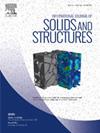机械皮肤疼痛与舒适评价模型在皮肤集成电子产品中的应用
IF 3.8
3区 工程技术
Q1 MECHANICS
International Journal of Solids and Structures
Pub Date : 2025-05-08
DOI:10.1016/j.ijsolstr.2025.113424
引用次数: 0
摘要
皮肤集成电子在医疗和健康监测方面受到了极大的关注。由于使用或设计不当,皮肤集成电子产品的使用者容易出现皮肤疼痛和不适,特别是神经系统受损的患者。基于人体疼痛感知的生理过程,提出了一种皮肤集成电子产品皮肤疼痛与舒适评价的理论模型。此外,还分析了神经胶质细胞减少对神经系统损伤引起的疼痛的影响。在多层皮肤力学模型、基于霍奇金-赫胥黎模型的神经信号转导、基于门控理论的传递与感知三种机械刺激下,对典型皮肤集成电子器件的皮肤痛觉进行了仿真分析。利用粘弹性理论对多层蒙皮的应力分布进行了有限元分析。在典型皮肤集成电子设备的三种不同机械刺激下,数值实验分别获得了快速疼痛反应和舒适设计所需的合适载荷。此外,还讨论了影响皮肤疼痛感知的因素,包括皮肤厚度和神经胶质细胞数量,这些因素可以为医疗应用中皮肤集成电子设备的设计提供帮助。本文章由计算机程序翻译,如有差异,请以英文原文为准。

Mechanical skin pain and comfort evaluation model applied to skin-integrated electronics
Skin-integrated electronics have received significant attention in medical and health monitoring. Due to improper usage or design, skin pains and discomfort tend to occur in users of skin-integrated electronics, particularly in patients with nervous system damage. This paper presented a theoretical model for evaluating the skin pain and comfort of skin-integrated electronics, based on the physiological process of human pain perception. Additionally, the impact of glial cell reduction on pain caused by damage to the nervous system was analyzed. The simulations were carried out to analyze the skin pain sensation under three different mechanical stimuli from typical skin-integrated electronics, which included: mechanics model of multilayer skin, nerve signal transduction based on Hodgkin-Huxley model, transmission and perception rooted in gate control theory. The stress distribution demonstrated by finite element analysis on the multilayer skin was produced using the viscoelasticity theory. Among three different mechanical stimuli from typical skin-integrated electronics, the numerical experiments obtained the appropriate load for rapid pain response and comfort design, respectively. Furthermore, factors influence the skin pain perception were discussed including skin thickness and number of glial cells, which could contribute to the design of skin-integrated electronics in medical applications.
求助全文
通过发布文献求助,成功后即可免费获取论文全文。
去求助
来源期刊
CiteScore
6.70
自引率
8.30%
发文量
405
审稿时长
70 days
期刊介绍:
The International Journal of Solids and Structures has as its objective the publication and dissemination of original research in Mechanics of Solids and Structures as a field of Applied Science and Engineering. It fosters thus the exchange of ideas among workers in different parts of the world and also among workers who emphasize different aspects of the foundations and applications of the field.
Standing as it does at the cross-roads of Materials Science, Life Sciences, Mathematics, Physics and Engineering Design, the Mechanics of Solids and Structures is experiencing considerable growth as a result of recent technological advances. The Journal, by providing an international medium of communication, is encouraging this growth and is encompassing all aspects of the field from the more classical problems of structural analysis to mechanics of solids continually interacting with other media and including fracture, flow, wave propagation, heat transfer, thermal effects in solids, optimum design methods, model analysis, structural topology and numerical techniques. Interest extends to both inorganic and organic solids and structures.

 求助内容:
求助内容: 应助结果提醒方式:
应助结果提醒方式:


